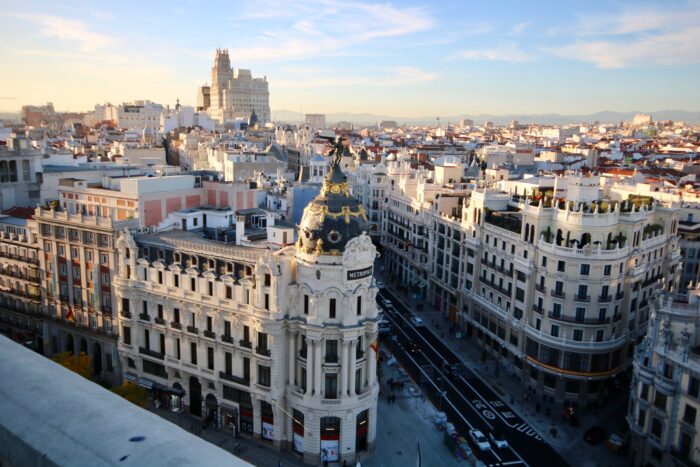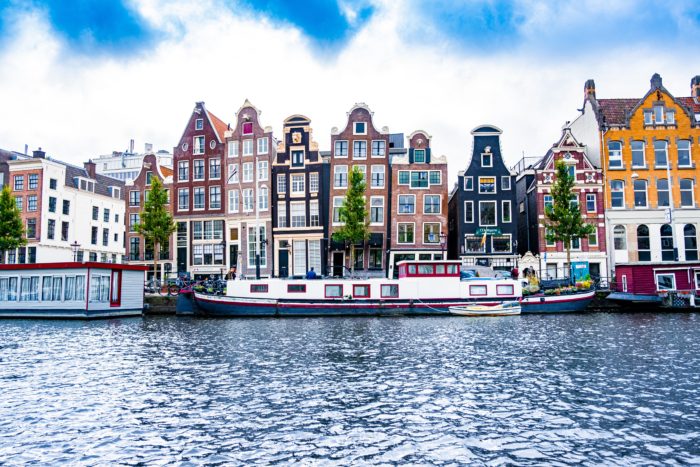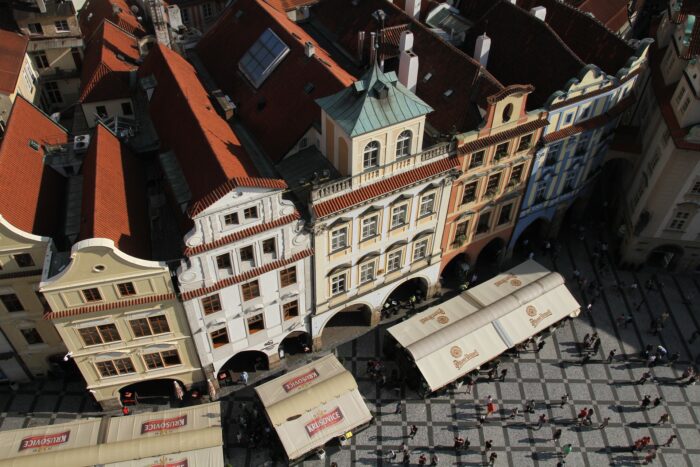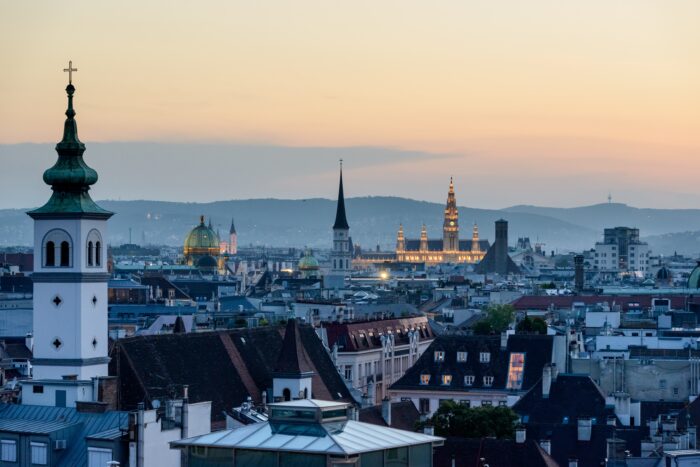The 14 Best Places to Live in Europe as an American
Are you tired of the American rat race? Are you yearning for a more fulfilling life? Maybe moving abroad is something you’ve been thinking about for years—maybe even decades. Well, you’re not alone. More and more Americans are seeking a new life overseas, whether it’s a few years of adventure, a permanent relocation, or a well-deserved retirement.
Of all the corners of the world, Europe is one of the top places to live and one of the most popular destinations for Americans. But the continent is vast and when choosing the best city in Europe to live, you might feel overwhelmed by all your choices.

What to consider when choosing the best place to live in Europe for an American
“Best” is a subjective term, right? If you do a quick Google search on the best places to live in Europe, you’ll be flooded with articles covering all kinds of perspectives:
- The best places to live in Europe for immigrants
- The best places to live in Europe for young adults
- The best places to live in Europe for families
- The best places to live in Europe for English speakers
- The best places to live in Europe in your 20s
As you can see—what’s best for one person might not be what someone else is looking for. Your age, your budget, whether or not you have kids, your personal interest and lifestyle all play a part in finding the best place in Europe for you.
Where is a good place to live in Europe for you?
When doing your research be sure to keep your priorities in mind. This will help you narrow down the right place for YOU. This list is my personal take, coming from a single, child-free, early 40s American woman who’s lived abroad on and off for over 20 years. My criteria for choosing the best countries and cities in Europe was based on factors like…
- Visa options: Can U.S. citizens easily secure residency?
- Cost of living: How does it compare to major U.S. cities?
- Healthcare: Is affordable health insurance accessible?
- Language: Is English widely spoken, or is the local language relatively easy to learn? *To fully immerse yourself abroad we always advise to learn the local language.
- Community: Are there vibrant expat communities? *While we’re advocates of integrating with locals, having fellow expats provides a comforting connection.
- Weather: Is it a mild or warm climate? *Personally I’m not a fan of the cold.
- Airport: Is there easy access to an international airport?
- Transportation: Can you navigate the city on foot or via public transport?
The 14 best cities to live in Europe for Americans (2024)
Ready to discover the greatest cities to live? We’ve compiled a list of the top 14 European cities, taking into account the criteria mentioned above and the overall quality of life. Unlike other lists out there, all these cities are in countries that offer practical visa options for Americans.
Although Nordic countries are often rank high for their superb quality of life, we’ve omitted cities from these countries since there’s no viable visa route for a regular American looking for long-term living. In no particular order, let’s dive into this list of the best cities to live in Europe!
1. Madrid, Spain
Spain’s capital city is one of the best places to live in Spain. Living in Madrid gives you everything you could ever want: an international—yet Spanish identity, electric atmosphere, non-stop cultural events and activities, and well-connected to the rest of Spain and Europe.
If you’re looking for a big city with a community vibe, lively social scene and a mild climate, then this is the city for you! I might be biased as I lived here for 5 years, but I’m not alone in my love for Madrid: more than 10,000 Americans live here, as well as thousands of foreigners from around the world.
Rent prices have risen quickly over the years but the city is still relatively affordable compared to other major cities in Europe. Spanish salaries remain low, however, we don’t suggest you look for work here. Your best option is to come on a digital nomad visa. With a US salary, the cost of living won’t be a challenge.

While it may come as a surprise, English is not widely spoken in Madrid. With the exception of younger Spaniards—who may speak some English but many are pretty shy about it—you need to learn Spanish in order to navigate living here. Especially as you get settled, do not expect people working at banks, government agencies, telephone companies or landlords to speak English.
Madrid’s public transport is extensive and easy to use: its metro system is cheap, clean and convenient; city buses will fill in the gaps and take you to any hard-to-reach places; and suburban trains will comfortably take you to towns outside the center. But the most efficient way to navigate the compact city center is on foot.
One myth I want to bust is…if you think that Madrid—and Spain as a whole—is hot year round—think again. That might be true during the summer, but be prepared to experience all four seasons. Learn more about moving to Spain from the US.
2. Malaga, Spain
Malaga, the birthplace of Pablo Picasso and Antonio Banderas, is a hotspot for families and retirees; but don’t let that fool you, it’s a lively metropolis on Spain’s southern coast. This active city’s culture and diversity attract people of all ages and from all over the world. And of course, with its location right on the Costa del Sol, there are infinite beaches at your doorstep.
Like most places, Malaga has felt the impact of rising housing costs as well. An influx of tourists, expats, and investors has negatively impacted the cost of living, unfortunately, it’s no longer the bargain it used to be. The average cost of groceries, entertainment, and transportation are relatively low.

For those who look forward to practicing their Spanish, locals speak with a Malagueño accent—which is notoriously difficult for the foreign ear. Given that Malaga is an international tourist hub, you can get by on English and Spanglish in the tourist areas.
Malaga’s summers are hot and humid and winters are almost nonexistent. In fact, compared to most other European cities of its size, it has one of the warmest winters. The city is in a prime location to explore the southern Spain and regional getaways including Cordoba, Seville, Granada. The Spanish long-distance train also connects to Madrid and Barcelona.
Walking is the perfect way to get around the city center. If you prefer two wheels, cycling is popular and the many bike paths make it easy to get around this bike-friendly city. Public transportation includes an efficient bus network and subway with two lines. Learn more about living in Malaga.
3. Lisbon, Portugal
Sometimes called the “San Francisco of Europe” for its hills, colorful trams and red suspension bridge, Lisbon attracted lots of foreigners and young creatives with its art scene and formerly low cost of living (but that’s been changing)—and it’s sparkling coastline and claim to fame as the sunniest capital in Europe.
This charming city will dazzle you with its expansive history—it’s the second-oldest European capital—centuries-old architecture, colorful Portuguese tiles and liberal mindset.
It’s a youthful city that tons of expats, techies and digital nomads have moved to, contributing to its vibrant community. Many come because Portugal is one of the easiest countries in Europe to move to given its viable visa options such as the new digital nomad visa, D7 visa, and entrepreneur visas.

While Portugal is one of the cheapest countries in Western Europe, the price of accommodation has skyrocketed—pushing locals out of city centers (you may want to think twice about moving here). For now, expenses like utilities, food, transportation, and private healthcare are all still highly affordable.
When it comes to communicating, English is much more common in Portugal than Spain, and widely spoken in Lisbon. As for transportation, Lisbon has an inexpensive and well connected transport system of metros and buses. The city center is walkable, but it can be quite hilly—again, think San Francisco.
The weather is mild but expect some periods of cold. The best part of Lisbon is that you get the atmosphere of a big city while also retaining the slower pace of a coastal town. Learn more in our guide to moving to Portugal from the US.
4. Porto, Portugal
Portugal’s second-largest city, Porto, is located about 200 miles north of Lisbon. With its lower cost of living (prices are rising fast here too), small-town charm and expanding food scene, Porto has been going through a bit of a revival.
Think of Porto as Lisbon’s little brother: a bit colder and wetter, and its smaller size means that it’s more manageable. On the flip side, it’s also less diverse and has a smaller international community. When choosing one over the other, don’t ask locals which city is better—as one forum user put it, “If you’re over 45 with a job, then Porto is the place. If you’re younger with no family, then Lisbon is the place.” Basically, it all depends on what you’re looking for.

Porto is much more affordable than Lisbon and like its bigger brother also attracts digital nomads, families, and retirees. English is widely spoken and there is a thriving social scene, so the opportunity to make friends and start fresh is fairly easy.
The city is much more manageable than Lisbon, so the best way to get around is to walk—but be ready for hills and stairs…this city will keep you in shape!
A couple of hours north of Porto is the Spanish border, where you can explore the lush, coastal region of Galicia. A few hours south and you’re in Lisbon. If you’re after warm weather, this may not be your perfect place. Given its location on the Atlantic Ocean and proximity to northern Spain there is no Mediterranean weather here. Summers are warm and sunny, but winters are rainier and colder than in Lisbon.
5. Berlin, Germany
What’s not to love about this creative, naturally hip, gritty yet glamorous, historically rich city—okay, except for maybe its winters? Berlin’s diverse food and culture, along with its booming startup scene has attracted entrepreneurs and talent from all over the world.
The city’s popularity and gentrification have wiped out the famously low rent prices of the early 2000s. While you can still live on less in Berlin compared to the U.S., the cost of living is more expensive than Spain and Portugal. In addition to housing prices, healthcare is more expensive (nothing compared to the US system) but eating out and entertainment are quite affordable.

We love Berlin for its diversity so when it comes to making friends there are endless options for community and finding your people. The city has become a prominent place for startups and tech companies. If you’re a techie looking for work this might be the city for you! In addition to a work visa, Germany offers an array of viable visa options to live here long-term—our favorite being the freelance visa.
Berlin is a sprawling city but well-connected by subway, bus, tram, suburban trains, and bikes. Winter will be your toughest months with little sunshine and extremely low temperatures, so come prepared and bundle up.
Last but not least, German is a difficult language but thankfully, English is widely spoken so getting around won’t be too hard! Learn more in our guide about moving to Germany from the US.
6. Amsterdam, The Netherlands
The Netherlands is one of the most egalitarian societies in Europe. It’s a welcoming country that is relatively easy to transition to and offers a special residency opportunity for American entrepreneurs through the DAFT-permit—if you’ve got a business idea, then this might be the place for you!
The most popular city in the Netherlands is Amsterdam; a small but mighty city with much to offer: a scenic backdrop, historic center, cultural diversity and a progressive society. It’s an international city that has attracted talent from all over the world; many global companies have headquarters there. Enjoy lounging in green parks when the weather is nice and socializing in cozy cafes and restaurants when it’s not.

Living in Amsterdam has many perks but keep in mind that Amsterdam is one of the most expensive cities in western Europe. In terms of languages, while Dutch is the official language, everyone speaks English here which makes it easy to navigate, but also leaves little incentive to learn Dutch.
When it comes to the weather expect to experience four seasons, even in the span of a day! Be prepared for rain, wind and cold. Cycling is the most popular way to get around, but if cycling is not your thing, the city is well-connected via train, tram, and subway. Learn more in our in our guide on moving to the Netherlands from the US.
7. Prague, Czech Republic
Foreigners flock to the Czech Republic for its magnificent history, bohemian culture and cheap prices. Most Americans settle in the country’s capital, Prague, one of the safest cities in the world and one of the most-visited and visually stunning cities in Europe.
The home of Franz Kafka and also known as “the City of a Hundred Spires,” Prague is known for its free spirit and being welcoming to foreigners. Does drinking have something to do with it? Czechs drink more beer per capita than anywhere else in the world, so cheap pints at and pubs are plentiful.
Prague has a relatively easy self-employment visa, making it a great option for English teachers and remote workers. There is also demand for skilled foreign workers. Average salaries are slowly increasing; but your money will go further if you work for an international company. If you’re wondering about being understood, beyond the tourist areas and among young people, English is not widely spoken. Start learning Czech now!

While salaries will be low, it’s comforting to know that the cost of living in Prague is well below that of major cities in western Europe. The average rent ranges from €600-€850 a month.
Healthcare in the Czech Republic is very good—so much so that it’s ranked as a top spot for medical tourism. The weather in Prague spans from cold winters and mild summers; July is the warmest month averaging at about 64 F.
Public transport is one of the best in Europe, very affordable with options such as trains, buses, trams, and suburban railways to get to your destination within the city, country, and cross-border. The country’s small size and central location make it ideal for those getaways all over Europe.
8. Zurich, Switzerland
Zurich is Switzerland’s largest city and one of the world’s financial centers. It’s often ranked as one of the most expensive cities to live in, but that’s due to an exceptionally high quality of life; outstanding education and healthcare, political and economic stability, safety, cleanliness and leisure all play a role in making it a top place to live.
This can create a bit of an expat bubble, meaning that although you might not have as many local friends, you can get involved in Zurich’s diverse international scene. On Sundays, the city shuts down as the Swiss escape for a dose of fresh air and outdoor activities like skiing, hiking, swimming or tubing. If you’re prepared to spend more, you’d be hard pressed to find a better place to live than Zurich.
The cost of living and daily expenses are high–but how expensive is expensive? Expect to pay anywhere between €2,500–€6,000/month* in Zurich and for a one-bedroom apartment. Local salaries compensate for cost of living, however the likelihood of obtaining a work visa is slim, but not impossible!

Zurich is a city with all four seasons, and leans heavily on the cold. Central Zurich is pretty compact and easily walkable. Public transport is quintessentially Swiss: efficient, clean and on time. A network of trams, buses and local trains will connect you to all corners of the city. Biking is also popular.
The city is in a prime location to explore the Alps, picture-perfect Swiss towns and pristine lakes. The country is centrally located and very small so you’re just a train ride away from Italy, Germany, Austria, and France.While almost everyone speaks English the country has four official languages, German, Swiss-German, Italian, and French.
*using € to be consistent with currency
9. Vienna, Austria
With ample green space, efficient public transportation and a low crime rate, Vienna consistently ranks as the city with the highest quality of life in the world. Not to mention its affordable housing, eco-friendly status, education system and more.
Located on the banks of the Danube river, it’s a city that fuses modern and classical culture. There are endless cultural activities—it was the home of Mozart and Beethoven after all—ranging from world-class theater to expansive museums.

Unlike other “most livable cities” Vienna actually has a manageable cost of living. Expect to pay anywhere from €500-€1100/month on rent. Your best bet to calling Austria home is through their equivalent of a non-lucrative visa.
Did you know that Austria is surrounded by eight other countries? This makes it the perfect place to start exploring the rest of Europe. But you don’t have to go far as Vienna is often praised for its proximity to nature, surrounded by lush green hills and hiking routes that are easily reached by train or car. Vienna experiences all four seasons and the amount of sun, wind, cold, snow you can expect varies greatly from region to region.
English is widely spoken but it’s best to learn some Austrian German or German to get by outside of the city. We love that Vienna is walkable and also has a top-notch public transportation system.
10. Cork, Ireland
Cork, located on Ireland’s southern coast, is the nation’s second-largest city. It might be known to tourists as the site of the Blarney Stone—kissing it supposedly gives you the gift of gab—but it’s also a place with a growing international scene and warm, friendly locals.
Cork is a lively city that attracts techies—it’s home to Apple’s European headquarters—and students, but with a smaller-city vibe. The compact center has a fresh food market, colorful buildings and a riverside harbor. And if you think Irish food is all stews and potatoes, think again. Cork is known as the food capital of Ireland, with gastropubs, fresh seafood, and craft beer and coffee scenes.

The cost of living in Cork is much less than that of Dublin. The average price of rent ranges from €1000-€1400 for a one bedroom apartment. English is the predominant language so there’s no stress on learning another language. This should help in the friend-making department, known for being warm and friendly, Corkonians are easy to strike up a conversation with.
Like much of Ireland, the weather in Cork is fairly mild. Rain is abundant throughout the year, in general though the weather can be unpredictable. If you can put up with the weather you’ll reap the benefits of majestic cliffs and beaches to farmland and historical towns, the south of Ireland is brimming with nature.
Walking is the best way to get around Cork, although cycling is becoming more popular. You can also use its extensive bus network to get around town or out to the suburbs. To get to neighboring towns or further (like Dublin), you can take a commuter train. Learn more about moving to Ireland from the US in our complete guide.
11. Paris, France
The “City of Light” hardly needs an introduction. As one of the most captivating cities in the world, it has charmed literary and fashion icons for centuries, from Ernest Hemingway to Coco Chanel. It’s not only the capital of France, but a global icon in terms of world-class art, architecture and gastronomy, and home to popular sites like the Louvre, Notre-Dame and the Eiffel Tower.
Cafe culture is an important part of the city, where friends meet to people-watch, chat over coffee and smoke—yes, that’s one cultural stereotype that still rings true today. Take a stroll along the Seine or wander through one of Paris’s 20 arrondissements, or neighborhoods; you never know what you’ll find. After all, Paris is one of the most multicultural cities in Europe: immigrants make up 20% of its population.

Since Paris is one of the most-visited cities in the world, you’ll shouldn’t have a problem getting by with English. However, knowing a little bit of French goes a long way, and will help you make friends with locals.
Paris is far from cheap. In fact, it’s more expensive than most cities in the world. Although living in Paris sounds like a dream for many Americans, skyrocketing housing prices are something to consider before making the leap.
You’ll most likely have access to the public health system which is one of the most efficient in the world. There are viable visa options to becoming a resident including a non-lucrative equivalent and self-employment and tech visa to name a few.
The city experiences all four seasons, from sweaty summer days to snowy winter ones and everything in between. There is so much to see and do in Paris alone but if you’re itching to travel there are plenty of nearby places to explore. Whether it’s a day outing to the Château of Versailles, a weekend excursion to the French Riviera or a trip to a neighboring country—Belgium,Germany, Luxembourg, Switzerland, Spain or Italy—you have plenty of vacation options. A national high-speed train system (TGV) means you can reach most of these destinations in a few hours.
Paris is a walkable city, but due to its size, the main form of public transport is the metro. The city also has public buses, trams, bike sharing, as well as a suburban train. Learn more about moving to France from the US in our guide.
13. Rome, Italy
The bustling Italian capital of Rome is often described as an open-air museum because its longstanding history and culture are on full display. Home to the Colosseum, Pantheon and Vatican, it’s a city of art, ancient ruins and pasta.
The grittiness and throngs of tourists might be a drawback for some, but for others there’s something magnetic about Rome. Despite living in a big city, Romans definitely know how to enjoy la dolce vita, as evidenced by their cafe culture and work-life balance.It’s an old city that is young at heart, inspiring many expats to call Rome home.
Rome certainly isn’t cheap, however, its cost of living is much better than in most major European capitals. You’ll need a salary of €1800-€3000 a month to live comfortably. The job market here isn’t great (and getting a work visa is quite difficult) but many international companies have offices in Rome; check to see if an in-company transfer is an option for you. If not, Italy’s non-lucrative equivalent or self-employment visa may be the best route to long-term living here.

Rome has a Mediterranean climate: summers are hot and humid and winters are mild. Luckily there’s plenty of sunshine during the winter, but don’t be fooled as temps can drop to freezing at night. Spring and fall are cool and see a fair amount of rainfall. Although there is no shortage of attractions in Rome, it’s a great jumping off point to explore other parts of Italy. A short drive west and you hit the beach, plus the beauties of Florence, Pompeii, Cinque Terre, the Amalfi Coast and more are only a train or car ride away.
Central Rome is easily explored on foot, but since other parts of the city are more spread out, you’ll probably need public transport to get there. Rome only has three subway lines, but it has an extensive bus network, although it can be unreliable with the city’s traffic. If you live beyond the city center, trams or the urban railway may be an option.
Learn more about moving to Italy from the US.
14. Athens
Athens is big and bustling—some might call it chaotic—but runs on a Mediterranean timetable. It’s often a stopover for tourists spending time in the idyllic Greek islands, but big city dwellers find themselves drawn to the capital’s energy. Although its economy is still struggling, Athens has become a haven for creatives for its inexpensive cost of living and underground art scene, drawing comparisons to Berlin in the 90s.
The graffiti-filled city isn’t for everyone, but each of Athens’s neighborhoods has a distinct personality, which lends a special character to it. There’s delicious Greek cuisine, from fresh seafood and salads to grilled meat and moussaka, all against a backdrop of magnificent landmarks marking the start of Western civilization.

The cost of living in Athens is significantly lower than other capital cities in Europe, especially when it comes to housing, although like everywhere, prices are rising. As with most major cities, living inside the city center will cost more. Greek salaries are also very low compared to North American standards, but if you’re coming with USD then your purchasing power will go a long way.
While there’s endless culture and entertainment in Athens, the city itself is surrounded by hills and seas, giving you plenty to explore: ancient ruins and temples, sun-drenched islands and remarkable landscapes. The city center is walkable, but taking the subway is probably the quickest and easiest way to get around town. Additional forms of public transport include bus, tram and suburban rail.
If you are a fan of warm weather, Athens Mediterranean climate is sunny and pleasant most of the year and winters are mild. It rains occasionally, mostly during the cooler months. Learn more about moving from the US to Greece in our complete guide.
Which are the best countries to live in Europe?
While certain countries are often recommended for American expats, it doesn’t mean they’re the perfect fit for everyone. What works for one person may not be ideal for another. As we mentioned, Scandinavian countries are frequently praised, but they lack viable visa options for average Americans.
When deciding on the best country to live in, the key factor is ensuring it has a suitable visa for your situation. This will vary by country. To simplify this, I’ve written the ultimate guide to European visas: I’m Outta Here! An American’s Ultimate Visa Guide to Living in Europe. Discover the 18 easiest countries in Europe to move to based on 50+ viable visa options.
Are you ready to move to Europe?
Now that you know where we consider the best places to live in Europe, are you ready to go? Let us know your short list!
If you want more information on how to move abroad, check out our resources:
- Sign up for the next Move Abroad After 30 Masterclass to see if a move abroad is a possibility for you!
- Join our Facebook group for women age 30 and up who want to move abroad
- Grab your copy of our Ultimate Visa Guide to Living in Europe as an American





15 thoughts on “The 14 Best Places to Live in Europe for Americans (2024)”
Why would these countries allow non euro citizens to live there????
Hi Magdalena, I’m not sure I understand your question. All countries in Europe allow non-European citizens to obtain some from of residency, whether that is short-term or long-term. Obtaining that residency is dependent on many factors. For instance many countries offer their version of the retirement visa. It’s a great benefit for a country because a foreign resident pumps money back into the economy without taking any funds out of the system. Hope that helps!
So helpful! Residencies are so different for Americans across Europe; definitely looking into Lisbon for myself 🙂
Thanks for reading along! Glad you found it helpful. If your interested in more information be sure to get on our mailing list for the upcoming e-book which will go in depth into 15 different countries in Europe where Americans have an opportunity of getting a long-term visa. Here’s the link: http://eepurl.com/dzE44D
I’ve researched moving to Spain as an American so many times. It is a great place to live, but seems so hard to really make it happen legally. But unless I teach English, find a serious boyfriend, or invest in the golden visa, seems nearly impossible to get residency. I’ve learned they have really cracked down on the non lucrative visa, esp people using it to work remote, so also not an option. Anything you would recommend besides those things? I work online so I’m not looking to actually work in the Spanish economy. But any other realistic options besides those listed above? Thanks and nice article!
Hi Lin! Thanks so much for taking the time to reach our article. Given your situation the non-lucrative would be the best option for you since you do not want to work in the Spanish economy. I haven’t heard of the government cracking down on any for having a non-lucrative, however, it is true that most (or maybe all) of the Spanish consulates in the U.S. are not approving non-lucrative applications that disclose remote work (I mention this in my new book https://shehitrefresh.com/move-to-europe-book/). In practice, many people who apply for the non-lucrative and meet the financial threshold for this visa do actually work remotely in Spain, they just do not disclose this in their application. If you have the financial means the non-lucrative is a pretty straight forward and quick option to getting residency in Spain.
Hey Cepee,
This is an awesome roundup of great places in Europe. As of 2021, your post will also become super relevant for British citizens who have lost their EU rights due to Brexit.
I’m a Brit who left the UK permanently in the summer of 2020 to escaped to Lisbon.
I chose Portugal because it ticks all the right boxes. Not only does it have great weather, food, and culture, but it also has the ‘non-habitual residency’ (NHR) program, which offers an extremely generous tax status for 10 years.
The NHR gives Portugal a massive advantage over Spain, especially for remote workers and online business owners. Portugal also has a relatively fast pathway to citizenship (5 years), which is my long-term goal. That will give me full rights to live, work, study and retire across the entire EU.
For Americans who want to move to Portugal, who already work remotely, the best option is the D7 visa and residency pathway combined with NHR. Also, anyone who is considering Portugal might want to check out the amazing island of Madeira…
Wishing you a Merry Christmas and a successful New Year!
Sam
Hi Sam,
Thank you so much for taking the time to read this post and for your kind words. Thank you for pointing out how the information will help those affected by Brexit.
Portugal is a wonderful choice for all the reasons you mention above especially that generous tax break for 10 years. Sounds like you made the bright choice! Best of luck on getting your Portuguese citizenship!
Wishing you all the best in 2021!
Cepee
Hi!
Any advice on moving to a more rural, green, and mountainous place with a baby and teenager? I’m definitely focusing on a place with cheap housing. I actually teach English as a second language here in the US currently so I’m hoping that could help. Any ideas?
Thanks!
Hi Dawn! There are some great small to mid size cities with green and mountains around. Malaga is a great example, I just relocated here from Madrid and love it! There are definitely more rural towns all around that are great for families. Check out our guide I’m Outta Here! for more cities in Europe, while we don’t include rural areas, you might want to ask in the expat FB groups in for the cities we include and ask about rural/green/mountainous nearby (I include many links in the book to useful FB groups where you can ask) https://shehitrefresh.com/move-to-europe-book/
Hi, Is there info in your book for a American to move to England? I have lived there before but it was through my marriage to French man. We are no longer married.
Hi Tina! Great question. Unfortunately England isn’t in the book. I just couldn’t find any viable ways for the average American to get a visa for long-term living. However, Ireland is the book in case if you are interested in moving next door 😉
One of the considerations that many web sites do not mention is the tax situation. The taxes in many European countries is draconian.
Spain, for example, has a wealth tax. Most of the countries also have very high inheritance taxes. The income taxes are also astronomical compared to the US.
It is definitely something to look into, especially if you have an income above poverty level.
Hi Gaius! That’s a great point. Taxes are a very complicated situation to get into for each country as they vary from country to country, how many days you spend in the country, your income and assets, and more! Definitely something people should consider when choosing where they want to move and also speak to a tax expert for the country you want to move to.
Great article! I really loved the list. Europe has so many great countries to live in. Portugal is my personal favorite. Because Portugal offers many advantages. The country has so many historical places and also beautiful beaches. And the people in Portugal are very kind. If you want to live abroad, Portugal is definitely a great option for sure.